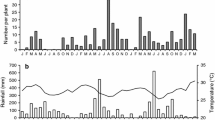Abstract
Three experimental plots were established and maintained during one year at two sites in the state of Querétaro, México, in order to identify species of parasitoids attacking the diamondback moth (DBM) Plutella xylostella (L.) (Lepidoptera: Plutellidae), and to gather information concerning their relative importance and patterns of population fluctuation. At both sites, the plots were planted with broccoli, cabbage and cauliflower during three cropping seasons. Parasitoid species identified were: Diadegma insulare Cresson, Diadromus (= Thyraeella) collaris Gravenhorst (Hymenoptera: Ichneumonidae); Habrobracon sp. (Hymenoptera: Braconidae); Oomyzus (= Tetrastichus) sokolowoskii Kurdjumov (Hymenoptera: Eulophidae); and Spilochalcis (= Conura) sp. (Hymenoptera: Chalcididae). This last species is a hyperparasitoid of D. insulare. The most abundant and frequently occurring species was D. insulare, it occurred in both localities during all three cropping seasons. The highest levels of parasitism caused by D. insulare on DBM were registered in the spring-summer season of 1996 at `La Soledad' farm with averages of 42.7, 45.0 and 44.5% on cabbage, broccoli, and cauliflower, respectively. Because D. insulare was detected attacking the pest at very low population densities during the initial stages of the crop cycle, it is assumed that the parasitoid has a high searching capacity. Correlation (r) between DBM and D. insulare population numbers was positive and significant. The other species identified occurred sporadically and had little impact on pest populations. The identification of D. collaris represents the first record of this species in North America.
Similar content being viewed by others
References
Bujanos, M.R., A. Marín Jarillo, F. Galván Castillo and F.K. Byerly Murphy, 1993. Manejo integrado de la palomilla dorso de diamante Plutella xylostella (L.) (Lepidoptera: Yponomeutidae) en el Bajío, México. Comité Técnico de la Asociación de Procesadores y Exportadores de Frutas y Vegetales en General. Celaya, Gto. México.
Carballo, M., M. Hernández and J.R. Quezada, 1989. Efectos de los insecticidas y de las malezas sobre Plutella xylostella (L.) y su parasitoide Diadegma insulare (Cress) en el cultivo del repollo. Manejo Integrado de Plagas 11: 1–20.
Cordero, J. and R.D. Cave, 1992. Natural enemies of Plutella xylostella (Lepidoptera: Plutellidae) on crucifers in Honduras. Entomophaga 37: 397–407.
Fitton, M. and A. Walker, 1992. Hymenopterous parasitoids associated with diamondback moth: the taxonomic dilemma. In: N.S. Talekar (ed), Diamondback Moth and other Crucifer Pests: Proc. of the Second International Workshop, 10–14 December 1990, Asian Vegetable Research and Development Center, Shanhua, Tainan, Taiwan. pp. 225–232.
Goodwin, S., 1979. Changes in numbers in the parasitoid complex associatied with the diamodback moth, Plutella xylostella (L.) (Lepidoptera) in Victoria. Aust. J. Zool. 27: 981–989.
Idris, A.B. and E. Grafius, 1995. Wildflowers as nectar sources for Diadegma insulare (Hymenoptera: Ichneumonidae), a parasitoid of diamondback moth (Lepidoptera: Yponomeutidae). Environ. Entomol. 24: 1726–1735.
Idris, A.B. and E. Grafius, 1996. Effects of wild and cultivated host plants on oviposition, survival, and development of diamondback moth (Lepidoptera: Plutellidae) and its parasitoid Diadegma insulare (Hymenoptera: Ichneumonidae). Environ. Entomol. 25: 825–833.
INEGI, 1986. Síntesis geográfica, nomenclator y anexo cartográfico del Estado de Querétaro. Instituto Nacional de Estadística, Geografía e Informática, México.
INEGI, 1995. Anuario estadístico del Estado de Querétaro de Arteaga. Instituto Nacional de Estadística, Geografía e Informática, México.
Jervis, M. and N. Kidd, 1996. Population dynamics. In: Insect Natural Enemies. Practical Approaches to their Study and Evaluation. Chapman & Hall, London, UK. pp. 223–292.
Lim, G.S., 1986. Biological control of diamondback moth. In: N.S. Talekar and T.D. Griggs (eds.), Diamondback Moth Management: Proc. of the First International Workshop, 11–15 March 1982, Asian Vegetable Research and Development Center, Shanhua, Tainan, Taiwan. pp. 156–167.
McCully, J.E. and M.D. Salas, 1992. Seasonal variation in populations of the principal insects causing contamination in processing broccoli and cauliflower in Central Mexico. In: N.S. Talekar (ed), Diamondback Moth and other Crucifer Pests: Proc. of the Second International Workshop, 10–14 December 1990, Asian Vegetable Research and Development Center, Shanhua, Tainan, Taiwan. pp. 51–63.
Morallo-Rejesus, B. and A. Sayaboc, 1992. Management of diamondback moth with Cotesia plutellae: prospects in the Philippines. In: N.S. Talekar (ed), Diamondback Moth and other Crucifer Pests: Proc. of the Second International Workshop, 10–14 December 1990, Asian Vegetable Research and Development Center, Shanhua, Tainan, Taiwan. pp. 279–286.
Poelking, A., 1992. Diamondback moth in the Philippines and its control with Diadegma semicalusum. In: N.S. Talekar (ed), Diamondback Moth and other Crucifer Pests: Proc. of the Second International Workshop, 10–14 December 1990, Asian Vegetable Research and Development Center, Shanhua, Tainan, Taiwan. pp. 297–308.
Quicke, D.L.J., 1997. Subfamily Braconinae. In: R.A. Wharton, P.M. Marsh and M.J. Sharkey (eds), Manual of the New World Genera of the Family Braconidae. International Society of Hymenopterists, Special Publication No. 1, Washington, D.C. pp. 149–174.
Salinas, P.J., 1986. Studies on diamondback moth in Venezuela with reference to other Latinoamerican countries. In: N.S. Talekar and T.D. Griggs (eds), Diamondback Moth Management: Proc. of the First International Workshop, 11–15 March 1982, Asian Vegetable Research and Development Center, Shanhua, Tainan, Taiwan. pp. 17–24.
SAS Institute, 1987. SAS/STAT user's guide, release 4.04 ed. SAS Institute, Cary, N.C.
Shigekazu, W., R. Tsukuta and F. Nakasuji, 1992. Effects of natural enemies, rainfall, temperature and host plants on survival and reproduction of the diamondback moth. In: N.S. Talekar (ed), Diamondback Moth and other Crucifer Pests: Proc. of the Second International Workshop, 10–14 December 1990, Asian Vegetable Research and Development Center, Shanhua, Tainan, Taiwan. pp. 15–26.
Talekar, N.S. and A.M. Shelton, 1993. Biology, ecology, and management of the diamondback moth. Annu. Rev. Entomol. 38: 275–301.
Author information
Authors and Affiliations
Corresponding author
Rights and permissions
About this article
Cite this article
Martínez-Castillo, M., Leyva, J., Cibrián-Tovar, J. et al. Parasitoid diversity and impact on populations of the diamondback moth Plutella xylostella (L.) on Brassica crops in central México. BioControl 47, 23–31 (2002). https://doi.org/10.1023/A:1014423106261
Issue Date:
DOI: https://doi.org/10.1023/A:1014423106261




